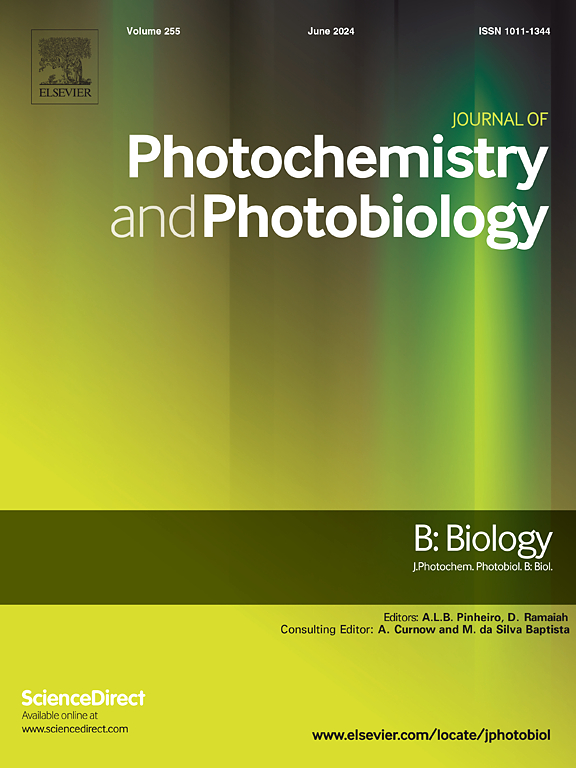Vicenin-2 reduces inflammation and apoptosis to relieve skin photoaging via suppressing GSK3β
IF 3.9
2区 生物学
Q2 BIOCHEMISTRY & MOLECULAR BIOLOGY
Journal of photochemistry and photobiology. B, Biology
Pub Date : 2025-02-06
DOI:10.1016/j.jphotobiol.2025.113117
引用次数: 0
Abstract
Background
Skin photoaging caused by ultraviolet rays (UVR) not only affects the appearance, but also leads to benign and malignant skin tumors. Vicenin-2, a bioflavonoid, exhibits anti-UVB properties, but its potential in preventing skin photoaging and the underlying mechanisms remain unclear. This study aims to elucidate the molecular mechanisms of Vicenin-2 in treating photoaging through network pharmacology, molecular docking, molecular dynamics simulation, and experimental validation.
Methods
We utilized PubChem, Swiss Target Prediction, and Target Net databases to obtain the action targets of Vicenin-2. The Online Mendelian Inheritance in Man (OMIM), GeneCards, and Therapeutic Target Database (TTD) databases were employed to hunt for photoaging-related targets. Gene Ontology (GO) and Kyoto Encyclopedia of Genes and Genomes (KEGG) enrichment analyses were conducted via the Metascape database. Molecular docking and dynamics simulation methods were used for analyzing the binding sites and binding energies between Vicenin-2 and photoaging targets. Then, a photoaging mouse model and a Human foreskin fibroblast cells (HFF-1) model were created, the therapeutic effect and molecular mechanism of action of Vicenin-2 were validated by Hematoxylin and eosin (H&E), Masson staining and Elastica-Van Gieson (EVG) Staining, enzyme-linked immunosorbent assay (ELISA), Western blot (WB), Terminal Deoxynucleotidyl Transferase dUTP Nick End Labeling (TUNEL) Assay, Antioxidant enzyme activities and quantitative reverse transcription-polymerase chain reaction (qRT-PCR).
Result
The screening of chemical composition and targets indicated that 249 genetic targets of Vicenin-2 were related to photoaging. Bioinformatics analysis suggested that Matrix Metalloproteinases 9(MMP9), Glycogen Synthase Kinase 3(GSK3β), Heat Shock Protein 90 AA1(HSP90AA1) and Nuclear Factor kappa-B1(NF-κB1) might be potential targets for Vicenin-2 in photoaging therapy. Molecular docking and dynamics simulation further showed that Vicenin-2 had the best binding to GSK3β. Through experimental verification, it has been demonstrated that Vicenin-2 alleviate photoaging, acting on GSK3β to regulate the phosphatidylinositol 3- kinase/serine-threonione kinase (PI3K/Akt) pathways, by reducing inflammation and apoptosis.
Conclusions
Vicenin-2 has anti-inflammatory and apoptosis-reducing effects through the action of multiple targets to relieve skin photoaging. Among them, GSK3β is the validated therapeutic target of Vicenin-2, which provides new ideas and clues for the development of photoaging therapy.
Vicenin-2通过抑制GSK3β减少炎症和细胞凋亡,缓解皮肤光老化
紫外线(UVR)引起的皮肤光老化不仅影响外观,还会导致皮肤良性和恶性肿瘤。Vicenin-2是一种生物类黄酮,具有抗uvb的特性,但其在防止皮肤光老化方面的潜力及其潜在机制尚不清楚。本研究旨在通过网络药理学、分子对接、分子动力学模拟和实验验证等手段阐明Vicenin-2治疗光老化的分子机制。方法利用PubChem、Swiss Target Prediction和Target Net数据库获取Vicenin-2的作用靶点。利用人类在线孟德尔遗传(OMIM)、GeneCards和治疗靶标数据库(TTD)数据库寻找与光老化相关的靶标。通过metscape数据库进行基因本体(GO)和京都基因与基因组百科全书(KEGG)富集分析。采用分子对接和动力学模拟方法分析了Vicenin-2与光老化靶点的结合位点和结合能。然后建立光老化小鼠模型和人包皮成纤维细胞(HFF-1)模型,通过苏木精和伊红(H&;E)、Masson染色和Elastica-Van Gieson (EVG)染色、酶联免疫吸附试验(ELISA)、Western blot (WB)、末端脱氧核苷转移酶dUTP Nick末端标记(TUNEL)试验验证Vicenin-2的治疗作用和分子机制。抗氧化酶活性与定量逆转录聚合酶链反应(qRT-PCR)。结果对Vicenin-2的化学成分和靶点进行筛选,发现有249个遗传靶点与光老化有关。生物信息学分析表明,基质金属蛋白酶9(MMP9)、糖原合成酶激酶3(GSK3β)、热休克蛋白90AA1 (HSP90AA1)和核因子κ b1 (NF-κB1)可能是Vicenin-2光老化治疗的潜在靶点。分子对接和动力学模拟进一步表明,Vicenin-2与GSK3β的结合效果最好。通过实验验证,Vicenin-2通过作用于GSK3β调节磷脂酰肌醇3-激酶/丝氨酸苏氨酸激酶(PI3K/Akt)通路,减轻光老化,减少炎症和细胞凋亡。结论vicenin -2通过多靶点作用,具有抗炎和减少细胞凋亡的作用,可缓解皮肤光老化。其中,GSK3β是Vicenin-2的经验证的治疗靶点,为光老化治疗的发展提供了新的思路和线索。
本文章由计算机程序翻译,如有差异,请以英文原文为准。
求助全文
约1分钟内获得全文
求助全文
来源期刊
CiteScore
12.10
自引率
1.90%
发文量
161
审稿时长
37 days
期刊介绍:
The Journal of Photochemistry and Photobiology B: Biology provides a forum for the publication of papers relating to the various aspects of photobiology, as well as a means for communication in this multidisciplinary field.
The scope includes:
- Bioluminescence
- Chronobiology
- DNA repair
- Environmental photobiology
- Nanotechnology in photobiology
- Photocarcinogenesis
- Photochemistry of biomolecules
- Photodynamic therapy
- Photomedicine
- Photomorphogenesis
- Photomovement
- Photoreception
- Photosensitization
- Photosynthesis
- Phototechnology
- Spectroscopy of biological systems
- UV and visible radiation effects and vision.
文献相关原料
公司名称
产品信息
索莱宝
Formalin

 求助内容:
求助内容: 应助结果提醒方式:
应助结果提醒方式:


